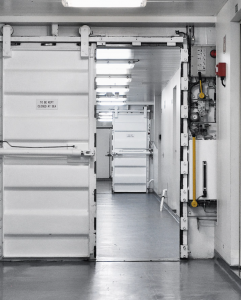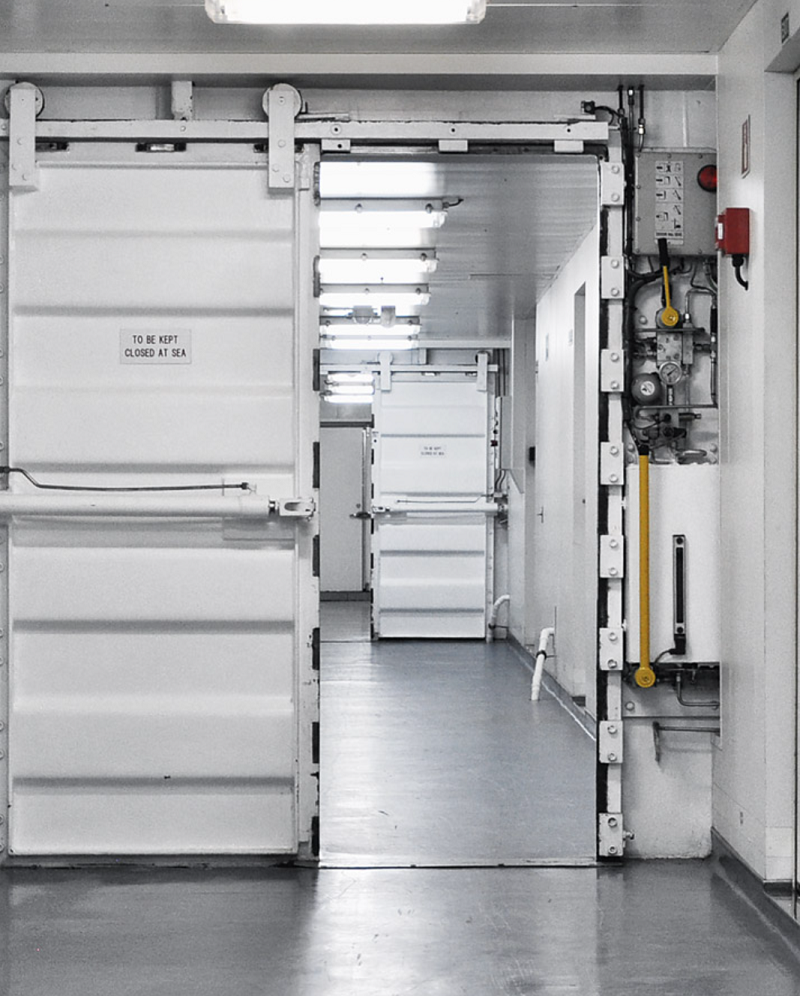Watertight doors are an essential safety feature found on ships, designed to prevent the passage of water in both directions between compartments during flooding or accidents. They are used in many locations on board, including the fore and aft passageways underdeck and in the engine room. Weathertight doors, on the other hand, are designed to withstand brief submersion and to withstand water pressure only from the outside.
Watertight doors are defined as being capable of preventing the passage of water in any direction under the head of water likely to occur in both intact and damaged conditions. Weathertight doors are designed to withstand any sea conditions to ensure that water does not penetrate the ship.
The proper use of watertight doors is critical in preventing accidents on board ships. Root cause investigations after incidents involving power-operated watertight doors have revealed that it has been common practice on board ships not to open watertight doors fully before passing through. Door safety systems have also been found not to be in full working order during inspections, and some doors were not properly maintained or tested. Most accidents involving people occur when the doors are in bridge-controlled “doors closed” mode.
Watertight doors are specialized types of doors designed to prevent the passage of water in both directions from one compartment to another during flooding or accidents on a ship. This article will explain the function and operational requirements of watertight doors and the importance of their proper use and maintenance in improving ship safety. Watertight doors are located below the waterline and can withstand continuous submersion, while weathertight doors are located above the waterline and can withstand brief submersion and water pressure only from the outside. In many common accident scenarios, including foundering, grounding, and collision, controlling the ship’s internal watertight integrity, and particularly the watertight doors, can make a significant difference in reducing loss of life and assets.
The article describes the technical systems that comprise watertight doors and the many possible failure modes and wear and tear that can occur. Experts at DNV GL and Gard have produced a package of training materials to raise awareness of the correct use of power-operated watertight doors, including a video and a presentation that identify key risks and technical and operational issues involved in using power-operated watertight doors. The article emphasizes the importance of procedures that describe correct operation during voyages and in emergency situations, as well as correct and efficient maintenance of watertight doors. The human element is also critical, with crew and officers needing awareness of the risks involved and their knowledge and motivation to operate the system correctly during normal operation and in cases of emergency.
The International Maritime Organization (IMO) recently revised its guidance for watertight doors on passenger ships, approving MSC.1/Circ.1564 on “Revised guidance for watertight doors on passenger ships which may be opened during navigation.” One amendment removed a provision in regulation II-1/22 that had permitted certain watertight doors to remain open during navigation if authorized by the administration. The article notes that casualty statistics indicate that watertight doors are not always used safely and properly, with root cause investigations after incidents involving power-operated watertight doors revealing that it has been common practice on board ships not to open watertight doors fully before passing through. Door safety systems have also been found not to be in full working order during inspections, and some doors were not properly maintained or tested. Most accidents involving people occur when the doors are in bridge-controlled “doors closed” mode.
In conclusion, watertight doors play a crucial role in preventing the passage of water between compartments on a ship, and their proper use and maintenance are essential for improving ship safety. Technical systems, procedures, and crew knowledge and awareness are all critical elements in ensuring the safe and effective operation of watertight doors. The article highlights the importance of proactive door-closing culture and preparedness for possible external events such as a collision or grounding or bad weather, emphasizing that being prepared can make all the difference in improving ship safety.

Watertight doors play a vital role in the safety of ships, as they prevent water ingress in case of flooding, thereby preserving the stability and buoyancy of the vessel. Watertight doors are classified into four types, namely, Type A, B, C, and D, based on their operating criteria. Type A doors can be left open and closed only in emergencies. Type B doors must remain open only when personnel are working in adjacent compartments, whereas Type C doors must remain closed at all times and opened only when personnel pass through them. Type D doors are not SOLAS compliant and must remain closed throughout the voyage.
Hazardous conditions arise when watertight doors need to be closed. These include situations of restricted visibility, high traffic density, and port limits that require compulsory pilotage. Watertight doors can further be classified as hinged or sliding doors, with the latter being powered by hydraulic cylinders or electric motors. While these doors are convenient and efficient, their power can pose significant risks if not handled with care. Crew members must be trained on the proper operating and maintenance procedures to avoid accidents, such as getting trapped in the door or losing fingers due to poor handling.
To ensure that watertight doors function correctly, drills for their operation must take place every week. The doors should be checked before leaving the port, and all hinged and power-operated doors should be operated daily during rounds. The doors must also be able to operate from both local and remote locations, and there should be an audio and visual alarm during closing, indicating both open and close positions. Solas regulations regarding closure of watertight doors must be followed strictly to ensure that the doors can be closed simultaneously from both the bridge and the Ship Control Center (SCC) within 60 seconds, and that they have an approximate uniform rate of closure under power. The door should also be capable of closing when the ship is listed to 15 degrees on either side, and controls for opening and closing the door should be clearly marked and easily accessible.
In conclusion, watertight doors are essential safety features in ships, and their proper operation and maintenance are critical to ensure the safety of the vessel and crew. Crew members must be trained on the correct procedures for operating and maintaining watertight doors, and regular drills must be conducted to test their functionality. Solas regulations must be followed strictly to ensure that the doors can be closed efficiently in case of emergencies.

